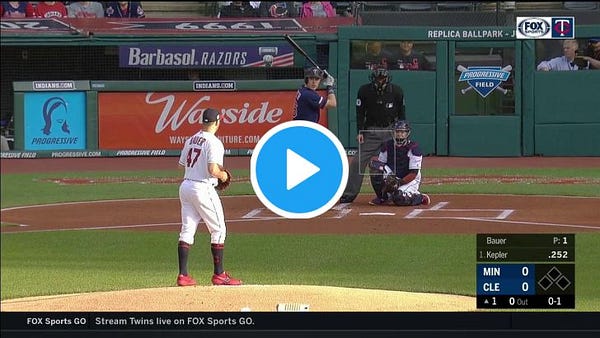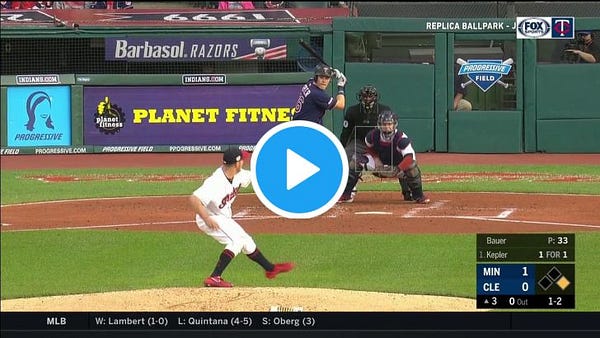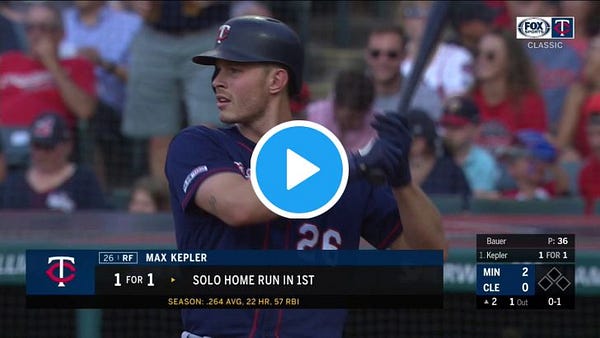Kepler, Mauer, Thames and our favorite Father's Day-related baseball moments of glory
Also featuring the second part of our KBO-to-MLB study
Happy Monday, Rich People.
We’ve got a lot for you in this edition, including some very loosely-related Father’s Day moments. Time to cut to the chase.
Let’s converse.
How do KBO numbers translate to MLB?
Mel Rojas Jr. Drew Rucinski. Eric Jokisch. Jose Miguel Fernandez. Preston Tucker. These are all names of players who, at best, were replacement-level in the major leagues but have gone onto be among the best players in the KBO this season.
The reasoning behind it is pretty simple. Major League Baseball is the toughest collection of competition in the world. Players who make it to that level in any capacity are very good. The KBO is also chock-full of good players, but it’s obviously just not to the level of MLB. Players, then, who are good enough to have played very recently in the bigs are likely to perform very well against KBO competition.
But how well are they likely to perform?
This was a question I first looked at in last week’s RPC when I examined the relationship between KBO and MLB performance by looking at pitchers who played in both leagues within a short time span from one to the other.
Now it’s time to look at the hitters, which, to me, is always more fun. Maybe that’s because I have a natural affinity for that side of the game as a former warning track power guy in high school.
To the findings!
The process
First, I’ll start by saying there’s a lot of potential caveats and different angles to spin off with this study. I can’t possibly get to them all without putting down another couple thousand words here and, trust me, nobody wants that. I’m not an expert statistician (there’s a reason I took zero, count ‘em, zero, math classes in college) but I think this is a solid foundational outline of the maths for this particular subject.
To kick things off, I had to choose which our stat categories to look at. Because of the nature of the sample sizes of the players that were part of the study, I wanted to avoid numbers that are more prone to be luck-influenced before they can stabilize over a longer period of games. As with pitchers, K% and BB% are among the fastest-stabilizing stats (stabilization points of 60 and 120 PA, via Pizza Cutter). With those two down, we’ve checked off two of the important facets of hitting.
Dealing with public KBO numbers limited the options for that third metric to look at; for example, exit velocity stabilizes very quickly, but not only is there very minimal KBO exit velo data but the Statcast era only encapsulates a small portion of the years we’re looking at for MLB players.
OBP, slugging, average, OPS and BABIP were all considered, but in the end, I went with isolated power. It stabilizes on average at 160 AB, faster than all the others, and it best measures that currently-missing element of power from what we have available.
Since the goal was to determine how MLB and KBO stats translate to one another, our sample involved exclusively players that, shocking revelation forthcoming, played in both leagues. I also looked only at players with a maximum of one year in between playing in each league as to minimize skill decline across our sample.
While the preference was players with at least a few-hundred PA in both leagues, I Included players who struggled in short samples in KBO as long as they had an established big league history. KBO foreign players who struggle early are often cut before turning things around; it’s just part of the process. Leaving them out would leave us with an incomplete sample.
Because of limits on foreign position players in the KBO, only 30 players since KBO started allowing foreign players qualified. I could only find eight players of those 30 who hit in the bigs immediately after time in the KBO.
I logged the career numbers for all players from both leagues and ended up with a total of 70,666 PA (over 46,000 KBO and 24,000 MLB).
When a player signs in MLB from the KBO and vice-versa, his very recent performance is often a large reason why. It could be an Eric Thames who socked dingers all the way until the Brewers felt compelled to sign him from the NC Dinos. Flip it around and it could be the more common theme: a guy simply can’t cut it anymore in MLB and heads to Korea. Because of this, I logged a player’s numbers again, but in the two years prior to switching leagues and the two years after. That way, more weight is applied to recent performance, much like any projection system does.
The results
Let’s start with isolated power, since hitting balls very hard and very far is the best thing you can do as a hitter.

The majority of foreign players in the KBO are there because, well, they couldn’t quite cut it in the big leagues anymore, so it makes sense that the numbers from the two-year MLB sample is worse than over the average of those players’ big league careers. Because this rings true for most players going over to the KBO, I don’t feel that this skews the sample significantly.
The flipside of this coin is that, I’d hypothesize, the two-year KBO power numbers specifically would be higher in this study than in actuality. While there aren’t a metric ton of players who come over to MLB after playing in the KBO, the ones that do are noticed by big league clubs because of typically standout performances--particularly with their power. And, usually, huge power spikes over individual seasons that aren’t in line with career averages aren’t sustainable. So even though our assumption is that, over a larger sample, a player’s skill level does not fluctuate dramatically over a four-year sample between leagues, players like Eric Thames and ByungHo Park are almost definitely due for some power regression when joining a MLB team.
The power spikes for those players right before coming over to MLB were very real, but just because Eric Thames had an isolated slugging percentage more than .130 points higher in his final two KBO years than his first two MLB years doesn’t mean that mean that we should expect that kind of power relationship for when Addison Russell begins play with Kiwoom (which, ew).
The tl;dr is this: our assumption that, over a 32,000 plate appearance sample, we can compare the two-year numbers across leagues no matter which league the player played in first because it will even out doesn’t work as well with isolated power unless the player is signing in MLB after he had a significant power spike in the KBO.
I hope you tracked that, because I’m not even sure I did. Fun!

What stands out is how much more stark the walk percentage KBO-to-MLB difference is for hitters compared to the pitchers. The pitchers had a career dip from 8.0% to 7.1% from MLB to KBO; compare that to the jump that hitters increase. Only two of the 30 hitters held a lower career BB% in the KBO than they did in MLB; Wilson Valdez and Lou Collier.
If a KBO team signs a foreign player with a modest-to-strong track record of drawing walks, the results will almost certainly be favorable; 8 of the 88 players with a BB% of at least 10% in the KBO since 2017 have posted a wRC+ of 100 or higher.

Of the three metrics we’re looking at, this one correlates the least with success at the plate. Swing-and-miss is often a trade-off of power, something that most (if not all) MLB teams have come around on over the past few years. Striking out is certainly just about the most sub-optimal outcome at the plate, but Peter Alonso (143 wRC+), Yoan Moncada (141), Jorge Soler (136), Eugenio Suarez (133), Luke Voit (126), Ronald Acuna (126), Trevor Story (121), Eloy Jimenez (116), Javier Baez (114), Danny Santana (111), Dan Vogelbach (111), Jake’s Large Son Franmil Reyes (109) and Domingo Santana (107) all had above-average wRC+ totals despite finishing in the top 17 in K%. 14 of the 20 players with the highest K% in the KBO this year have a wRC+ of 102 or higher.
What I wanted to find out from the outset was what we could expect from a player who is headed from one league to another. Determining that requires the percent increase/decrease in the three categories from one league to the other. Here’s what we’ve got.
MLB to KBO
Career ISO: 26.3% increase
Career K%: 26.8% decrease
Career BB%: 38.5% increase
2-year ISO: 54.0% increase
2-year K%: 24.7% decrease
2-year BB%: 39.5% increase
Compare those numbers to the pitchers’.
Career K%: 14.5% increase
Career BB%: 11.3% decrease
Career ERA: 24.9% decrease
2-year K%: 9.4% increase
2-year BB%: 13.9% decrease
2-year ERA: 24.4% decrease
Whoa.
Next, the KBO to MLB hitting numbers
Career ISO: 20.8% decrease
Career K%: 36.7% increase
Career BB%: 27.8% decrease
2-year ISO: 35.1% decrease
2-year K%: 32.7% increase
2-year BB%: 28.3% decrease
Practical application!
These calculations wouldn’t be the only factors that go into projecting a player’s cross-league performance, of course. But it’s a start.
There’s also the question of how to properly weigh both the career and two-year numbers when applying the percentages to projections. That’s another separate project, likely. But, for the sake of finishing this story with something we can sink our teeth into, let’s halve their weights and apply them to a relevant player.
Perhaps no player is more relevant to the MLB-to-KBO discussion right now than Addison Russell, who was just signed by Tom’s Kiwoom Heroes despite a very detailed history of domestic abuse, but we have no need whatsoever to give him any more thought and attention than he’s already gotten.
Instead, let’s roughly project what future Milwaukee Brewer Sung-bum Na (who is likely to sign with a MLB team this offseason) would do in his first year in the bigs.
Working off Na’s career and recent KBO numbers, here are the RPC projections for a 2021 Major League season from my beloved left-handed slugger.
ISO: .198
BB%: 6.1%
K%: 30.1%
There’s a lot of the framework still to fill out here, but the numbers aren’t exactly promising. Na projects as below league-average in walks (8.5% league-wide in 2019) and K% (23.0) and only above-average in isolated power (.183, although there’s gotta be some juiced ball that could help his cause lost in translation here).
These numbers don’t bode super well for Na; Jackie Bradley Jr. had a .196 ISO, 27.3 K% and 9.9 BB% last year and a 90 wRC+, although some factors unaccounted for in this exercise could give Na’s projection a boost.
His walk numbers have increased since the early years of his career, which are bringing the projection down a bit. Three of his four sub-.230 ISO numbers were in the first three years of his career, with his power figures currently the best they’ve ever been.
Of course, there’s also more to a hitter’s numbers than walks, strikeouts and isolated power. Na’s BABIP has always been excellent (.397, .374, .371, .413, .378 from 2014-18; he played only 23 games last year but had a .476 mark) and that batted ball skill would likely translate. No longer being tasked with shouldering a huge offensive load on a MLB team, perhaps he could take advantage of fewer starts against lefties.
Now let’s have a team sign him and see how wrong I am.
Father’s Day Conversations
Baseball is great. Dad’s Day is cool, too. Here’s our favorite instances of baseball fatherings.
When Max Kepler became Trevor Bauer’s father
~Tom
Baseball and dads. Two things that will always go together.
Whether it’s Kevin Costner asking Ghost Dad to “have a catch” in “Field of Dreams,” Jimmy Morris giving the game ball to Stern Dad at the end of “The Rookie” or “All the Way Mae” and her prevalent daddy issues in “A League of Their Own,” baseball and father-child relationships seem to always go hand-in-hand in Hollywood.
Occasionally, the dynamic translates to the play on the field.
On June 6, 2019, Twins outfielder Max Kepler dug into the batter’s box to face Cleveland starter Trevor Bauer. Kepler entered the day with a cute little .252/.324/.490 slash line, coming in cold after a rough 0-for-4 outing the previous night. Kepler homered in his first at-bat. And again in his second. And, yup, the third as well. When he went to sleep that night, Kepler was the owner of a shiny, new .266/.337/.542 slash.
On July 13, 2019, Kepler squared off against Bauer again. He homered on the third pitch of the game, and hammered another an inning later.
That means Kepler took Bauer yard in five consecutive at-bats. According to STATS, he’s the first player to do it against the same pitcher in the same season.
It’s enough where Bauer needs to officially Call Him Daddy—no, not the unlistenable Barstool Sports podcast, but simply out of respect for Kepler’s barrel.
To be fair, Bauer was a great sport about it. The right-hander posted a detailed and slightly self-deprecating breakdown of all five homers, giving viewers insight on what he was thinking at just about every pitch. Watch it. You’ll learn something.
Now that you’ve learned a few things and are now qualified to be a pitching coach for Ron Gardenhire, let’s dive into the nonsense. To honor his status as Bauer’s Daddy on this Father’s Day, we’re grading Kepler’s five dingers.
HOMER #1
CONTEXT: Minnesota entered a three-game series with a commanding 11.5-game lead over the Indians. However, the Twins dropped the opening pair of contests and were desperately hoping to salvage a win in the series finale.
SWING: C-. It’s odd to say Kepler was fooled by Bauer’s 85 mph changeup since the ball flew out of Progressive Field. But it wasn’t his most commanding swing. Kepler, who was out in front of the pitch, used his hands to stay behind the ball and flicked it into the right-field seats.
BAT FLIP: C. Not even Kepler’s mother thought this ball was going out, so we’re cutting Max some slack here.
BAUER’S REACTION: B-. He handled this one like a pro.

Homer #2
CONTEXT: Two innings later, Kepler homered again to give the Twins a 3-0 lead. It was his second multi-bomba game of the season and first since a 9-2 thrashing of Baltimore on April 27.
SWING: B+. Bauer definitely didn’t learn from the first at-bat. He gave Kepler the exact same pitch in the same spot, and Kepler drove it deeper into the bleachers. Unlike his first tater of the day, Kepler’s second bomb would’ve been a homer even if the ball wasn’t juiced.
BAT FLIP: A-. In the words of JVN, “Gorgeous, hunny.” Kepler held his bat high towards the sky as he watched the seams of the baseball float into the polluted Cleveland air.
BAUER’S REACTION: A. Obviously frustrated, Bauer did a little Sad Boi Baseball Flip as he slumped back onto the rubber.

Homer #3
CONTEXT: Despite allowing two moonshots to Kepler early in the game, Bauer continued to labor into the seventh inning. Kepler went yard again for his second career three-homer game. His first was against—you guessed it—the Indians on Aug. 1, 2016.
SWING: A+. Bauer tossed his worst pitch of the day -- a 95 mph fastball towards the lower half of the strike zone. Serving up Kepler low heat is like handing That Guy the microphone on karaoke night. You’re never seeing it again.Kepler’s third hack of the day was his finest.
BAT FLIP: B. Nothing flashy here. Strictly business. A casual three-homer night.
BAUER’S REACTION: B+. Transcribing Bauer’s words and thoughts here would result in Rich People Conversations getting the axe from Substack due to severe FCC violations. We’ll let your imagination run wild.

Homer #4
CONTEXT: It’s now early July, and the Indians are red hot. They’ve trimmed Minnesota’s double-digit game lead in the AL Central to 6.5 games, and are hosting the Twins for another three-game set. Kepler led off the game in style.
SWING: A. Again with the low heat, Trevor?
BAT FLIP: A+++++. A thing of beauty. Kepler gave the bat a swift flick, and it proceeded to skip end-over-end towards the Twins’ dugout like a slinky walking down the stairs.
BAUER’S REACTION: A. Bauer’s shoulders slumped so low they are now part of the Progressive Field mound and can be used as the rosin bag.

Homer #5
CONTEXT: Four at-bats, four taters. It had to be in Bauer’s head by now. Kepler would go on to mash his 23rd homer of the season -- five of those off of Bauer’s hand. Yikes.
SWING: A+. The high cheese wasn’t working. Nothing low in the zone was working, either. So Bauer hung a 79 mph curve up in the zone and, whack. Again, into the seats.
BAT FLIP: B+. Any display of showboating here would honestly be cruel. Instead of flipping the bat into orbit, Kepler just signed Bauer’s birth certificate as his official Father.
BAUER’S REACTION: A+ times infinity. Our favorite screenshot of all time. Bauer has the look of someone who invented the world’s first time-traveling machine in 2014 and randomly chose to check out 2020, only to discover the shocking sh*tstorm we’re currently living in.
Yep. That’s 100% accurate.

Jake, Joe and Justin
~Jake
On May 24, 2009, the M&M Boys became the M&M Daddies.
It was an ESPN game against the Milwaukee Brewers, in the Crew’s final game under the tarp at the Metrodome. Admittedly, tensions weren’t super high given it was May and the Brewers were managed by somebody named Ken Macha, but the stage was set nevertheless. Fatherhood was nigh.
Joe Mauer was the first to be welcomed to fatherhood when he became Dave Bush’s daddy in the bottom of the first inning. Mauer turned on a floating 85 mile per hour cutter and pulled the ball way deep into the right-centerfield bleachers. Not the folded up ones hiding behind the baggy; no, Mauer swatted the ball just shy of the Kirby Puckett banner in the upper deck.
A ton of 6-foot-4 left-handed hitters have upper deck power to right-centerfield, but this was a moonshot for Uncle Joe. It may have been the peak of Mauer’s power, an absolute blast in a year where he hit a career-high 28 dingers and won the AL MVP. It was a glimpse into his true power, a tease for what could have been.
Also, it was off Dave Bush, which is just funny for some reason.
(Side notes about this game: Our beloved Carlos Gomez led off the game for the Twins and Mauer was batting second--way to go Gardy! After the game, Mauer was batting .438/.525/.875; Craig Counsell led off the game for the Crew; Scott Baker somehow pitched 8-1/3 innings, allowing three runs and snagging the win.)
Justin Morneau became a father later in the game while Bush was gratefully on the bench. With the bases juiced and the Twins leading 2-1 in the bottom of the seventh, Morneau stepped up to the plate against Mitch Stetter, an actual name of a former big leaguer, apparently. It went--well, it went as well as you might expect it to go for a future MVP against a guy named Mitch.
Stetter tossed a 77 mile per hour frisbee belt-high and Morneau crushed it, putting it mere feet away from Mauer’s shot six innings earlier. Stetter, a situational lefty who appeared in 71 games and threw just 45 innings in 2009 (lol), had a new daddy.
A couple of screenshots to commemorate the occasion:

Moments before the 0-0 pitch to Morneau, Brewers pitching coach Bill Castro is trying to call literally anyone to throw. Stetter had just entered the game for Bush and plunked Mauer to load the bases.
That location is not optimal. Josh Hader, Mitch is not.
Sorry to all of our Brewers readers.
You’re welcome, Twins fans.
(Curt note: Don’t apologize, Jake. On behalf of all of Milwaukee, we accept any and all Ken Macha slander.)
When Eric Thames became the Reds’ dad
There are many Dad associations in my baseball-watching history.
In early September 2008, with the Brewers a couple games ahead of the Mets in the Wild Card race, my dad took me to a Crew-Mets game at Miller Park. It was a weeknight and Milwaukee fell behind early but fired back with a four-run fourth to tie the game at five. It stayed that way through nine innings. I had school the next morning, as did my brothers, and he had work. But, very on #brand, I sweet-talked my way into getting us all to stay at least for a couple extra innings; this was the first good Brewers team I had ever seen and they were playing meaningful baseball! Naturally, the Mets tallied a(n unearned) run in the top half of the 10th. The Crew did not score in the bottom half. I then learned how crushing and, quite honestly, mean the sport of baseball was.
But that’s not where I’m going with the rest of this section. And I’m not going in the direction of the following, either, although they all involve fathering in some way.
I’d be remiss not to mention Pedro calling the Yankees his daddy.
Ryan Braun at Wrigley Field.
Also Ryan Braun in the state of Pennsylvania.
Also Ryan Braun vs. Dominic Leone
John Axford blowing his first save in 50 tries just as his wife went into labor, resulting in him leaving a note explaining it all at his locker for reporters.
Christian Yelich hitting two cycles against the Reds in the span of like a month.
Christian Yelich vs. the entire league, really.
Those were or are all beautiful moments in baseball of a man being someone else’s daddy, both literally and figuratively.
My favorite moment, though, is not any of those simply because none can match the splendor that was 2017 Eric Thames Against Cincinnati.


For an entire season--and, more gloriously, the month of April--our large forearmed king ate Reds pitching for breakfast, then went back to the fridge, grabbed the milk, poured it into his bowl, mixed in another serving of Reds pitching and devoured that, too. In 17 games against Cincy that year, Thames hit .351/.493/.895 with 10 dingers. His OPS of 1.388 was 135 percent better than the league-average mark.
The majority of that damage all came in the month of April, too.
Thames was in his first month as a Brewer after a stint in Korea that got him a three-year deal in MLB. There was an aura of ridiculousness about his first month that I don’t know if any Brewers player can quite ever match. He finished with a club-record 11 dingers, 19 RBIs, a .466 OBP and 1.276 OPS.
He could have stepped away from baseball on the spot and still have provided the Brewers fair value to the contract they gave him.

Thames was quite literally the most talked-about baseball player in the world for a two-week stretch there in which he socked 10 dingaroos in 13 games.
That stretch all started with a game against the Reds on April 13 where he went 2-for-3 and hit a homer. Then he went yard the next day against Wandy Peralta, who is largely irrelevant here but once waved to me after I said, “Hello, Wandy” at Miller Park. I am guessing Wandy Peralta doesn’t get too many non-Reds fans at opposing ballparks greeting him by his first name. On the third day, Thames homered twice. Then, he launched his fifth homer of the four-game series the following day.
Fast forward to April 24 and Thames has homered twice more, including one long ball that broke John Lackey. (I very distinctly remember watching that game back in our newsroom office in Willmar, Minnesota, with Jake sitting directly across from me. It was at that point that we collectively lost our minds at what Eric freaking Thames was doing to baseball.) The Reds were in Milwaukee to start a three-game set a mere eight days after Thames had tormented them.
And for whatever reason, they pitched to him.
First at-bat. Bomb.
Second at-bat. Bomb.
Thames was now their daddy.
Cincy walked him two times later in that game, once intentionally. But they had to make the trek back to One Brewers Way the next day and, sure enough, after going 0-for-2 with a walk to start, Thames took Robert Stephenson yard in the sixth for his eighth homer in six games against the Reds.
I did a Twitter search of “Eric Thames Reds” just to see what beautiful old relics popped up.





(Hey look it me)
Thames would, of course, eventually come back down to earth. He homered twice against Cincy the remainder of the season and scuffled overall in both June and August.
2018 didn’t go as well, as he was left off the postseason roster, but rest assured, he still tortured the Reds. The Brewers won back-to-back 2-0 ballgames in April against the Reds in which the only runs came on Thames two-run jacks. Later in the year, he parked a three-run homer with two outs in the seventh to take a 5-4 lead.
Eric Thames was not a perfect player in his three years in Milwaukee, but he was, on the whole, a good one and nobody can say he wasn’t fun to watch. And for a couple weeks in April 2017, the whole world watched as he became the paternal custody holder of the Cincinnati Reds.




